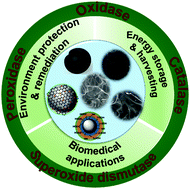Prospects of nano-carbons as emerging catalysts for enzyme-mimetic applications
Abstract
It is of enormous scientific and practical significance to develop nanozymes, i.e., enzyme-mimicking nanomaterials, to overcome the instability, difficult storage, and high cost of natural enzymes. The field of enzyme mimetics has advanced significantly after the emergence of nano-carbons due to their unique structure and properties. The large specific surface area of nano-carbons maximizes their active sites and accelerates electron transfer in catalytic reactions, helping them serve as direct surrogates to natural enzymes. This review presents insights into the recent advancements and key approaches towards the capability of nano-carbons as a catalyst to trigger advances in enzyme mimetics that have revolutionized the nanozyme sector. The structure–property relationship and unique features of nano-carbons regulating their catalytic behavior are also briefly discussed. Further, the respective mechanisms are summarized and discussed along with the applications of carbon-based nanozymes in different fields from biosensor design and environmental monitoring to therapeutics. The review concludes with the key scientific issues facing nano-carbons as catalysts and future perspectives on maximizing their benefits at the nanozyme nexus and beyond.

- This article is part of the themed collections: Celebrating International Women’s Day: Women in Materials Science and Recent Review Articles


 Please wait while we load your content...
Please wait while we load your content...